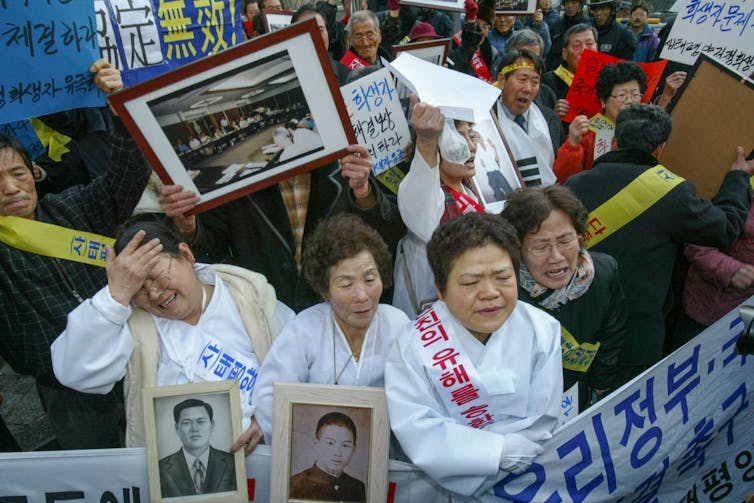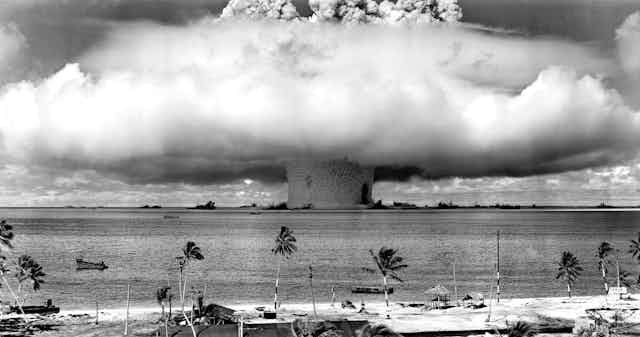With 13 Oscars nominations and seven wins – including best picture – “Oppenheimer” was the star of the 96th Academy Awards.
Christopher Nolan’s blockbuster, which told the story of the making of the atomic bombs that were dropped on Hiroshima and Nagasaki, added to its awards season haul that includes five Golden Globes and seven BAFTA awards.
But as a historian whose research has revolved around the survivors of the bombings, I cannot help but be disappointed that, yet again, the dominant narrative of the bombs chugs along.
This narrative has long informed how Hollywood and the U.S. media have addressed nuclear weapons. It paints the bombs’ creation as a morally fraught but necessary project – an extraordinary invention by exceptional minds, a national project that was a matter of life or death for a country mired in a global conflict. To use the bombs was a difficult decision at a challenging time. Yet it’s important to remember that, above all, the bombs saved democracy.
There is something that strikes me as so inward-looking to this narrative – it is so focused on the stress over losing an arms race, on fears of making a mistake, on anxiety over what would happen if bombs were to one day be dropped on the U.S. – that it drowns out what actually did happen after the bombs were detonated.
A barren cultural landscape
When Nolan was pressed over why he chose not to show any images of Hiroshima, Nagasaki or the victims, he said, “less can be more” – that the subtext of what’s not shown is even more powerful, since it forces audiences to use their imaginations.
But what images from popular culture do audiences even have to pull from?
From the 1950s to the 1980s, many Hollywood films explored the fear of a nuclear apocalypse. Only a few depicted mass deaths on the ground – “The Day After” comes to mind – but virtually none showed survivors who looked or sounded like real survivors.

Instead, films such as “Dr. Strangelove or: How I Learned to Stop Worrying and Love the Bomb” simply showed mushroom clouds and bird’s-eye views of the bombs from above. When cameras did zoom in on the ground in films such as “Panic in Year Zero!” and “Testament,” they revealed Americans bracing for or panicking about the bomb being dropped on them.
Watching these films, it’s easy to believe that if a nuclear attack had ever occurred, it must have been in a U.S. city.
This genealogy of films also includes collective biopics of a sort, in which a nuclear drama unfolds among scientists, military officials and politicians.
In the 2024 book “Resisting the Nuclear: Art and Activism across the Pacific,” one chapter describes how Oppenheimer and Albert Einstein reenacted the Trinity test in “Atomic Power,” a 1946 film that celebrates the role of science in U.S. military might. They note that in the film’s outtakes, Einstein seemed unfocused while Oppenheimer appeared stilted.
Clearly, the two scientists were uncomfortable with their newly assigned role as promoters of a mesmerizing, dangerous technology. If “Oppenheimer” expands on this personal discomfort, the film keeps firmly in place the disconnect between the bombs’ creators and the destruction they wrought.
The bombs didn’t discriminate
In the end, films like “Oppenheimer” offer few, if any, new insights about the bombings of Hiroshima and Nagasaki and their repercussions.
More than 200,000 people perished, and the lives lost included not only Japanese civilians but also Koreans who had been in Japan as forced laborers or military conscripts.
In fact, 1 in every 10 people who survived the bomb were Koreans, but the U.S. government has never recognized them as survivors of U.S. military attacks. To this day they struggle to get access to medical treatment for their long-term radiation illness.

Moreover, about 3,000 to 4,000 of those affected by the bombs were Americans of Japanese ancestry, as I have shown in my book about Asian American survivors of the bombings. Most of them were children who were staying with their families, or students who had enrolled in schools in Japan prior to the war because U.S. schools had become increasingly discriminatory to Asian American students.
These non-Japanese survivors – including many U.S.-born citizens – have been known to scholars and activists since at least the 1990s. So it feels surreal to watch a film that depicts the bombs’ effects purely in the context of the U.S. at war against its enemy, Japan. As my work shows, the bombs didn’t discriminate between friend and foe.
It is not that Christopher Nolan ignores the bombs’ power to destroy.
He gestures toward it when he depicts J. Robert Oppenheimer, the nuclear physicist played by Cillian Murphy, imagining a nuclear holocaust when giving a celebratory speech to his colleagues after the bomb was dropped on Hiroshima.
But what Oppenheimer sees in this hallucination is the face of a young white woman peeling off – played by Nolan’s daughter, Flora – not those of the Japanese, Korean and Asian American people who actually experienced the bombs. Later in the film, Oppenheimer looks away from the images of Hiroshima’s ground zero when they’re shown to him and his Manhattan Project colleagues.
I wondered, as I watched this scene, whether this decision encourages the audience to look away, too.
Global reverberations
Even if this film is seen purely through the lens of entertainment, Nolan could have chosen to recognize why the bombs are such a galvanizing subject to begin with: They have done much, much more than make white, middle-class Americans feel anxious or guilty.
Their blasts reverberated across the globe, tearing apart not only America’s wartime enemies but also colonized peoples and racial minorities.
Cold War nuclear production disproportionately hurt Native and Indigenous Americans who worked at uranium mines and the residents of the Pacific Islands chosen as the sites of several dozens of U.S. nuclear tests.
For those on the receiving end, the effects of the nuclear explosions are not a thing of the past. They are a daily reality.
And the effects of radiation continue to plague not just humans but the environment. Scientists still don’t know what to do with highly radioactive nuclear waste, whether it’s from nuclear power plants or former nuclear test sites that remain off-limits because they are too contaminated to inhabit.
As global conflicts increase the possibility of nuclear war, it’s certainly important to talk about the ongoing legacies of the bombings of Hiroshima and Nagasaki.
But to create a more balanced understanding of nuclear weapons, it would be helpful if talented filmmakers like Nolan made more of an effort to look beyond the narrow immediacy of a mushroom cloud.

